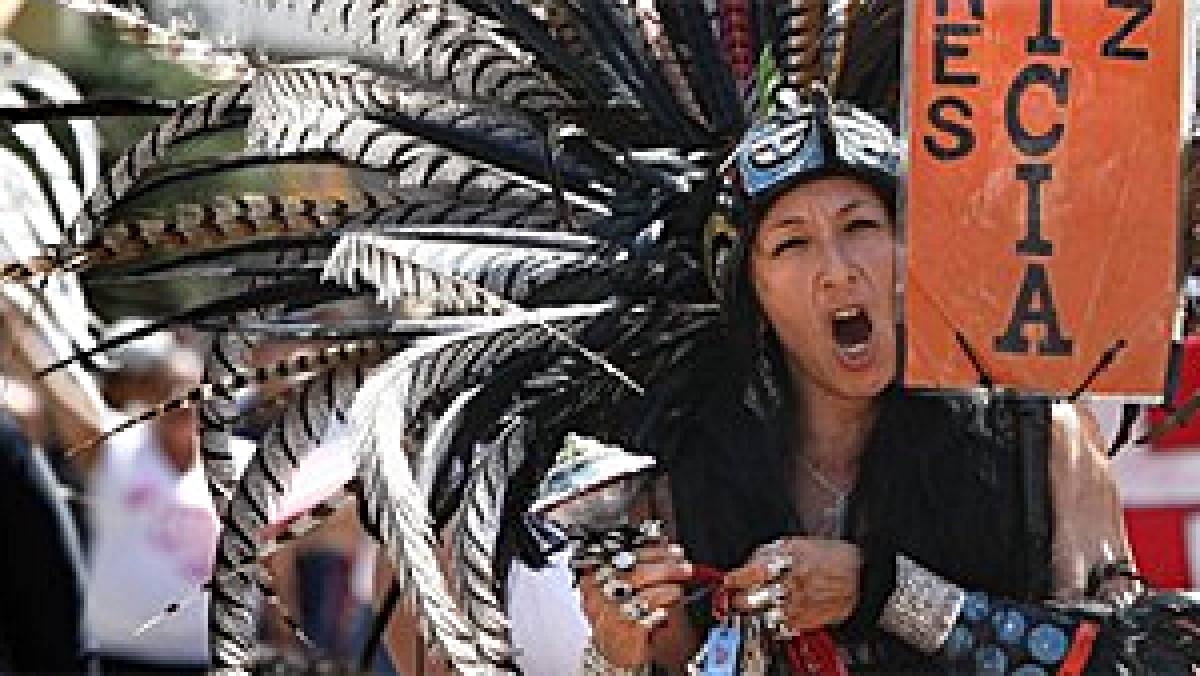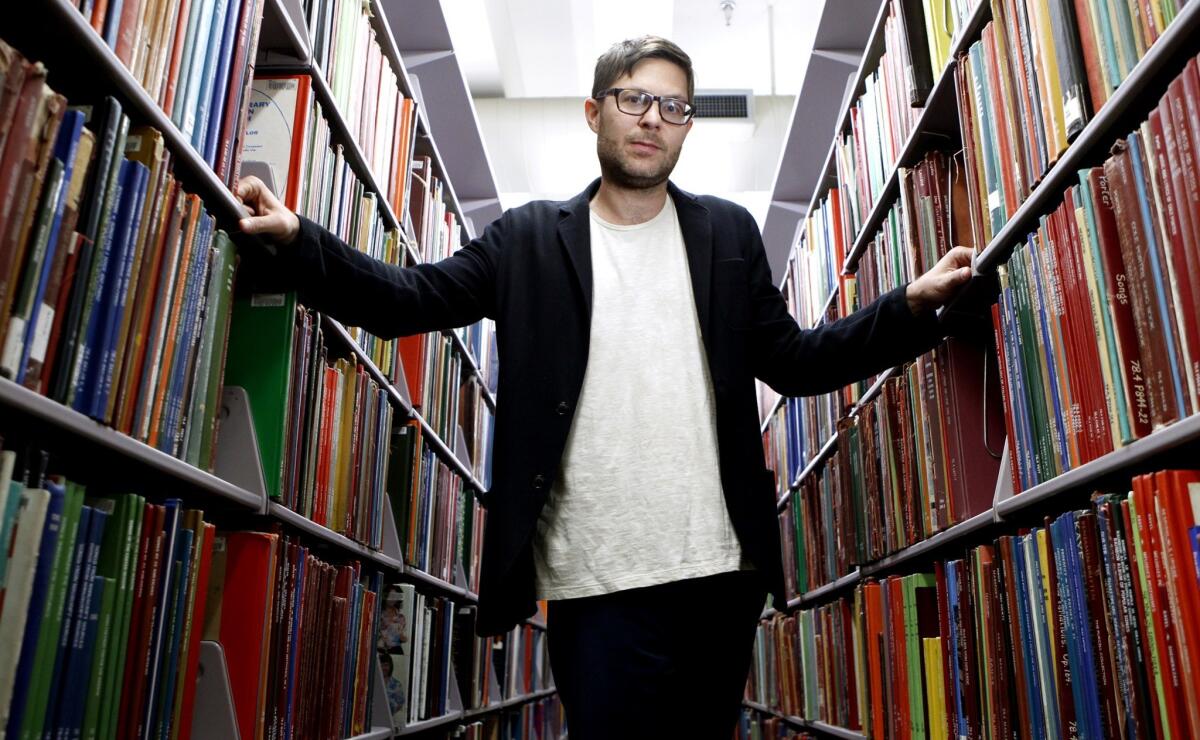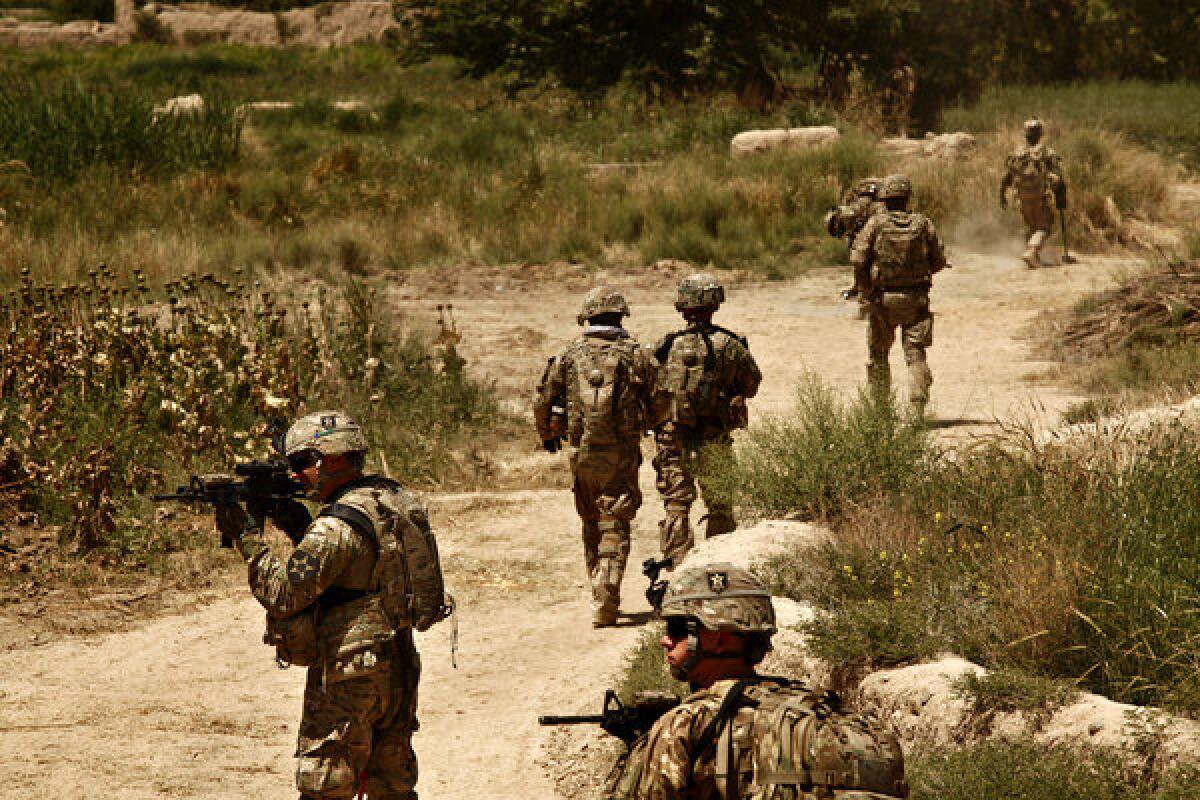Pair of ‘geeks’ sifts through history for aviation ruins
Peter Merlin and Tony Moore, self-confessed aviation geeks, find and sort through military crash sites in the Mojave as a hobby. They call these weekend expeditions ‘aerospace archaeology.’
- Share via
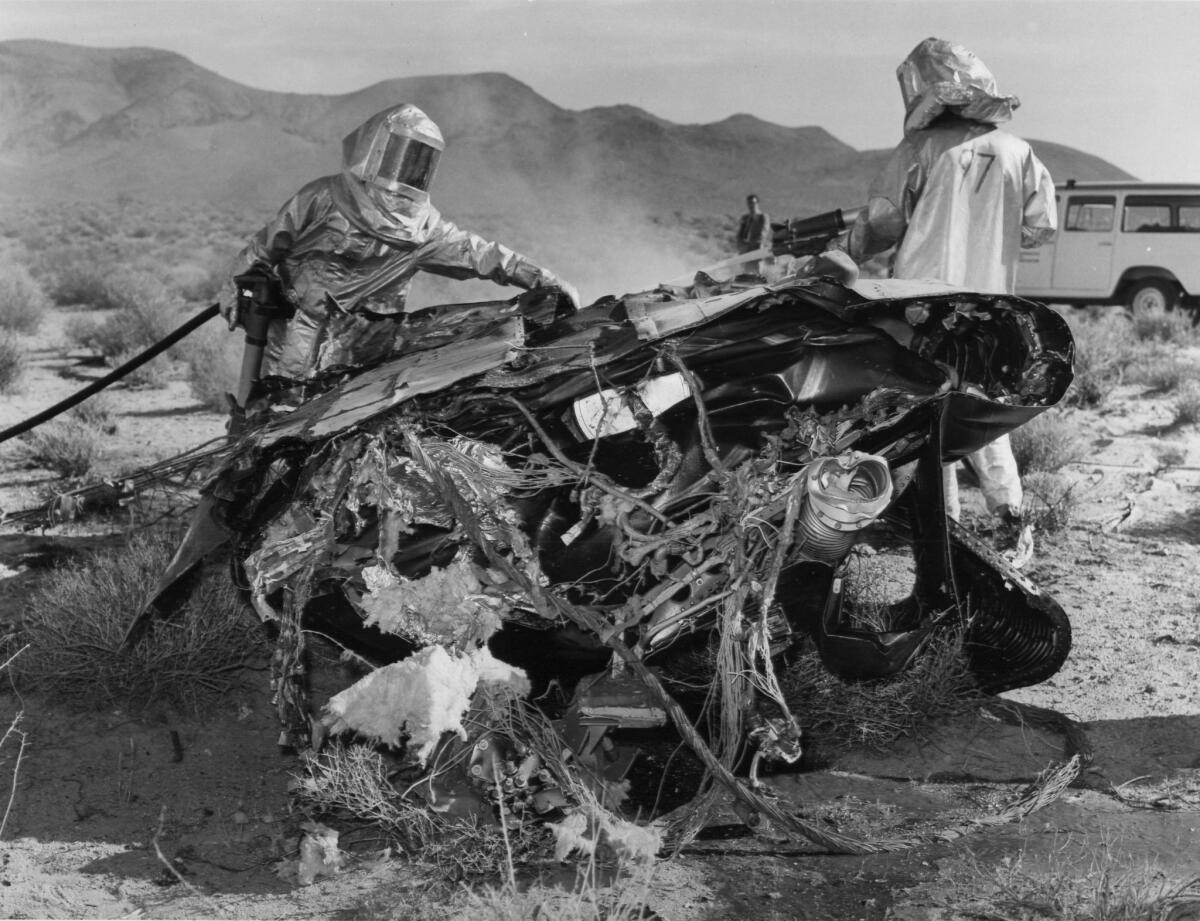
Peter Merlin trudges through the desert, side-stepping sage brush and creosote until he reaches a spot barren of vegetation. He points out a faint crescent-shaped scar in the earth 100 feet long.
Merlin kneels and scoops up a handful of sand and lets it sift through his fingers, leaving behind three gray pebbles, each no bigger than a quarter.
"See these rocks?" he asks. "They're actually fragments of melted aluminum. This is the impact point where the flying wing crashed, and the crew lost their lives. Right here. This is the incident that gave Edwards Air Force Base its name."
The pebbles were remnants of the YB-49, an experimental bomber that crashed in 1948 carrying Capt. Glen Edwards and a crew of four. His untimely death prompted the military to rename Muroc Air Force Base in his honor.
Finding and sorting through military crash sites in the Mojave is Merlin's hobby and pastime. He and Tony Moore, his partner on these weekend expeditions, call it "aerospace archaeology."
"Living this close to Edwards is like an Egyptologist living in Egypt," Merlin said. "It has been called the 'valley of the kings.'"
The skies above the Mojave Desert are legendary. The first American jet plane flew here. The sound barrier was broken here. Space shuttles returned to Earth here. But less heralded are the failures and crashes, tragic footnotes to these remarkable accomplishments.
Merlin and Moore refer to themselves as "The X-Hunters," a nod to the Air Force's use of "X" in naming experimental planes. Their findings have broadened the military's understanding of Southern California's aerospace history.
"Their value to the office is a great one," said Richard Hallion, a retired official who worked 20 years as an Air Force historian. "In many cases, there was only rough approximation of where the crashes took place."
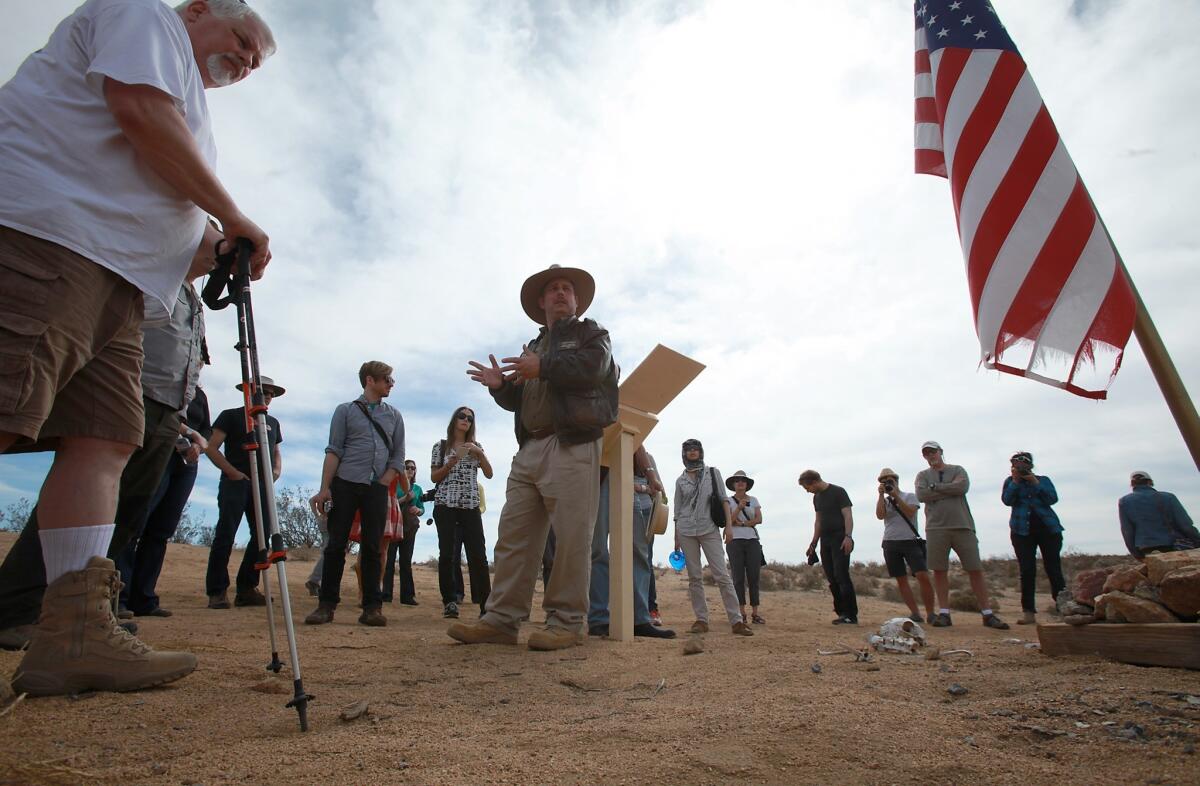
Peter Merlin, center, and Tony Moore, left, at a memorial to the crew of an ill-fated YB-49 test flight near Mojave. (Brian van der Brug / Los Angeles Times) More photos
Despite the vastness of the Mojave, there are few crash sites that Merlin and Moore have yet to find. They have compiled a list of more than 600 locations amid the sun-scorched sand and rock, and so far they have examined more than 100.
Merlin and Moore are unlikely confederates. Merlin, 49, the introvert, is prone to extended pauses when talking. He has a thin Errol Flynn-esque mustache and is known to wear a safari hat and leather jacket with "The X-Hunters" emblazoned on the back.
Moore, 55, is a large, affable man who walks with a metal trekking pole because of bad hips. He grew up in Northridge and has long been fascinated with Edwards, and seems to have a story about any aircraft that was ever built.
They both work at Edwards, but in 1991 the self-confessed aviation geeks were employed at the Burbank airport when they had a conversation about the region's aerospace history. Moore told Merlin he had found the wreckage site of the XB-70, an experimental bomber that collided with an F-104 in 1966.
Merlin was intrigued. But aviation buffs are secretive about the information they have — like fishermen who won't tell where the big ones are — so Moore gave Merlin vague directions to the site: about 12 miles north of Barstow.
The following Monday, Merlin came to work, smiling. He had found the site.
"I was shocked," Moore said. "I must have given him a two-mile area to search through. But he found it, to his credit."
After recognizing their shared infatuation, they decided to team up. When the two men started researching airplane wrecks, they mostly relied on files from the Edwards History museum and a 1993 environmental impact study of the base that listed only 15 sites.
On their first expedition, Moore and Merlin turned to a book written by a former test pilot that documented the crash of Maj. Michael Adams, who was killed in 1967 when the North American Aviation X-15 rocket plane he was piloting broke up at 62,000 feet while traveling at 4,000 mph.
According to the book, the wreckage was located several miles northeast of Johannesburg. But once they arrived at the spot, the terrain didn't resemble what was depicted in the book's grainy black and white photographs.
After several hours of fruitless searching, they decided to head home. As they drove toward U.S. 395, Moore noticed a mountain in the distance that looked like one pictured in the book.
They pulled onto a dirt road and rumbled toward the mountain. More landmarks began to line up. There was a ridge with an outcropping of white rocks near its crest.
They got out of their Jeep and began walking toward the mountain, stopping at intervals to consult the book. Merlin then looked at the ground and saw a piece of weather-beaten metal tubing.
"We're here," he shouted, noticing the ground was littered with more metal fragments.
For two years, they combed over the debris field and recovered 125 pounds of parts, including a warning light that likely glowed in the cockpit while Adams fought to save himself and the aircraft. These items are at the flight test museum at Edwards.
A memorial now marks the site. It was erected in 2004. More than 60 people, including Merlin, Moore and members of Adams' family, attended the dedication.
"We often approach these sites from a historical perspective," Merlin said. "But there's a human element that lives on. To see the emotional reaction from the family really showed me how much the sites can mean to people."
Among their other finds was the crash site for another flying wing, an experimental bomber constructed of wood, dubbed the N-9M. The plane went down 12 miles west of Edwards in 1943.
The men also located pieces of the Bell X-2, which in 1956 tumbled out of control, killing test pilot Capt. Milburn Apt on impact in the Kramer Hills off the eastern edge of the base.
Seven miles west of California City, they found the location of the NF-104A crash that would have killed Chuck Yeager in 1963 had he not ejected in time. A more recent non-fatal wreck was the X-31 that crashed less than a half-mile from California 58 in 1995.
When a plane goes down in the desert, the military tries to recover as much of the wreckage as possible. Retrieving hefty, hulking pieces is a priority.
I've seen enough deflated Mickey Mouse balloons to last me a lifetime."— Peter Merlin
Most of the time, Merlin and Moore are searching for smaller parts such as twisted stainless-steel skin, rusted fasteners and fittings, or crushed cowl flaps.
They scan the horizon for glinting metal when they think they're in the right spot. Once they uncovered a part of a tail fin. But finding such items is rare, and often what they think is an aircraft part shimmering in the distance ends up being a Mylar balloon.
"I've seen enough deflated Mickey Mouse balloons to last me a lifetime," Merlin said.
When they do find something that they think they can identify, they take it home and weigh and measure it. They verify the part's authenticity by chasing down serial numbers, inspection stamps or examining a manufacturer's book on the aircraft. After documenting it, they'll donate it to the flight test museum or other institutions. They have written a book about their exploits titled "X-Plane Crashes."
Critics believe that the significance of the men's findings is slightly exaggerated. Raymond Puffer, retired Edwards historian, said their work is more of a hobby than anything else.
Other explorers, like G. Pat Macha, prefer to leave the crash sites intact.
"That's a big issue in this field: To simply take a picture or take the stuff home with you," said Macha, 67, who has identified and documented crash sites in Southern California for 50 years.
Macha, however, appreciates that rather than holding onto what they have recovered, the two men have given their findings back to the base.
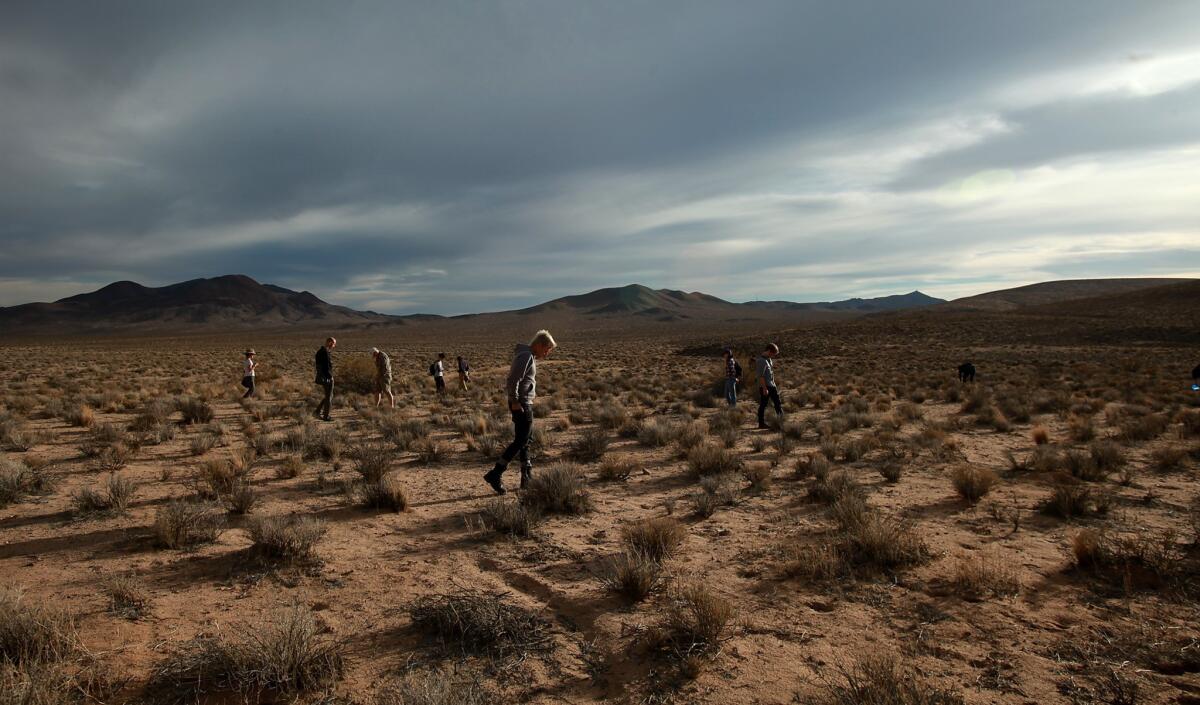
Tourists scour the Mojave Desert landscape on the lookout for debris from a 1967 X-15 crash near Johannesburg. (Brian van der Brug / Los Angeles Times) More photos
Merlin and Moore take pride helping families who have lost a son or a father in one of these fatal crashes.
While standing at the YB-49 crash site that killed Edwards, Moore saw something glimmering in the dirt. He picked it up: It was a star sapphire, perfect except for a slight chip on one side.
The small stone was a mystery until Moore was talking to an engineer who had been on the base the day the YB-49 crashed.
The engineer mentioned that a member of the crew, Maj. Daniel H. Forbes, had been married just a few weeks before the accident. His wife had given him a sapphire ring. The military had found the setting but not the stone.
Moore was stunned: "We found the stone," he said. "We found it five years ago right in the middle of the site.'"
He mailed a photograph of the sapphire to Air Force personnel, who went to visit Forbes' widow.
A half-century had passed since the tragedy. The widow had remarried and at first didn't seem to remember the ring. Then they showed her the pictures.
Without saying a word, she walked to her bedroom and returned with a matching star-sapphire ring in her hand. The stone was eventually returned to her in a ceremony at the Kansas air base that bears Daniel Forbes' name.
"It's unbelievable how many things needed to happen in order for that ring to be reunited with her," Moore said. "It validated all our work."
Inside the business of entertainment
The Wide Shot brings you news, analysis and insights on everything from streaming wars to production — and what it all means for the future.
You may occasionally receive promotional content from the Los Angeles Times.
